Mayapple
- October 17, 2023
- 0 comment
Mayapple, scientifically known as Podophyllum peltatum, is a fascinating herbaceous plant native to the woodlands of eastern North America. This distinctive plant is known for its umbrella-like leaves, which form a lush, carpet-like ground cover in the spring and summer months. In April and May, mayapple produces a single, nodding flower with waxy, white petals and a central “apple” that’s hidden beneath its umbrella-like leaves.

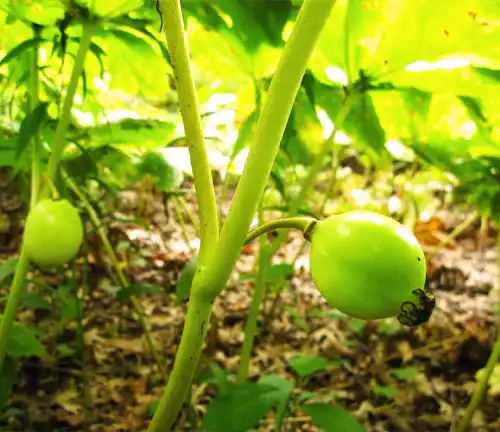
Despite its enticing appearance, the mayapple fruit is typically considered toxic when not fully ripe. However, once the fruit turns yellow, it can be consumed in moderation. Mayapple has a long history of traditional medicinal uses among indigenous peoples, but it should be used cautiously, as various parts of the plant contain potentially harmful compounds.
This unique and enchanting plant, with its charming and mysterious qualities, remains a delightful addition to woodland ecosystems and gardens alike.
| Characteristics | Description |
| Scientific Name | Podophyllum peltatum |
| Common Names | Mayapple, American mandrake, wild mandrake |
| Family | Berberidaceae |
| Native Range | Eastern North America |
| Habitat | Woodlands, shaded areas |
| Plant Type | Herbaceous perennial |
| Height | Typically 12-18 inches (30-45 cm) |
| Leaves | Umbrella-like, palmately lobed, 1-2 feet (30-60 cm) wide |
| Flowers | Single, nodding, with white waxy petals |
| Blooming Period | April to May |
| Fruit | Yellowish “apple” when ripe |
| Toxicity | Various parts of the plant may contain toxic compounds |
| Traditional Uses | Medicinal purposes in indigenous cultures |
| Garden Use | Ornamental ground cover in shade gardens |
Botanical Beauty of Mayapple
Mayapple, or Podophyllum peltatum, stands out as a botanical gem in the woodlands of eastern North America. Its distinctive features make it an enchanting addition to any natural landscape or garden. The umbrella-like leaves of Mayapple create a captivating carpet of green, providing an aesthetic spectacle that captures the imagination of all who encounter it. Its scientific name, Podophyllum peltatum, reflects its unique appearance, with “podophyllum” derived from the Greek words “pous” (foot) and “phyllon” (leaf), alluding to the shape of its leaves. This plant is a true testament to the wonder of nature.
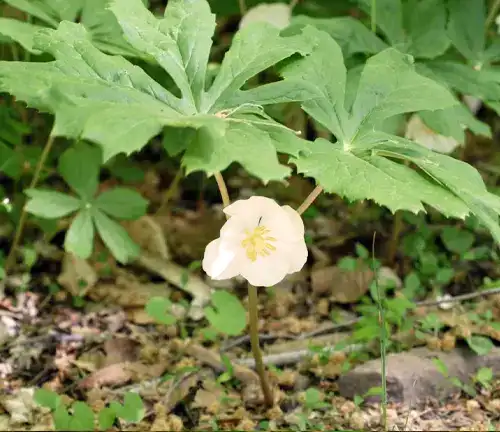
Woodland Elegance
Mayapple’s presence in the forest understory lends an air of elegance to these natural habitats. The palmately lobed leaves stretch wide, resembling a multitude of delicate green parasols. Their lush appearance offers a serene contrast to the sometimes dimly lit woodlands. Mayapple thrives in shaded environments, making it a prime example of nature’s adaptation to specific niches within ecosystems. Its aesthetic value in woodlands has made it a sought-after plant for shade gardens and natural landscaping.

Ecological Importance
Beyond its aesthetic appeal, Mayapple plays a vital ecological role in woodland ecosystems. Its dense foliage provides shade and shelter for various wildlife, from insects to small mammals. The plant’s presence helps maintain the overall health and biodiversity of the forest floor. Additionally, the leaves and fruit serve as a food source for select species, contributing to the intricate web of life within these ecosystems.
Cultivation and Conservation
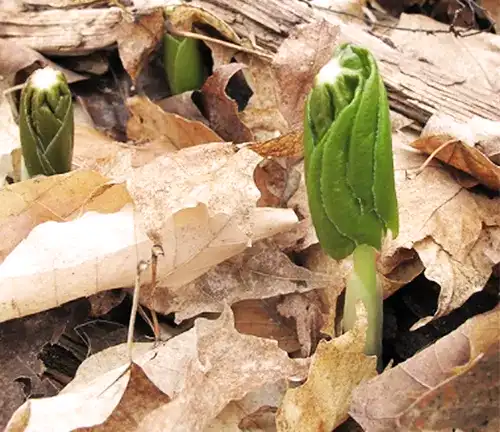
Cultivating Mayapple in gardens requires an understanding of its specific habitat preferences. Woodland settings with dappled sunlight and well-drained soil are ideal for its growth. However, it is essential to note that Mayapple is a slow-spreading plant and may take several years to establish. Conservation efforts are crucial because the plant is sensitive to habitat loss and overharvesting. In some regions, it is protected by laws to preserve its natural populations.
Fragrance
One of the unique qualities of Mayapple is its distinct fragrance, especially when the plant is in bloom. The single, nodding flower features waxy, white petals and exudes a sweet scent that captivates the senses. This fragrance, combined with the plant’s striking appearance, makes Mayapple a delightful addition to gardens and woodlands.
Soil Stabilization
Mayapple’s extensive root system contributes to soil stabilization, preventing erosion in woodland areas. Its roots help hold the forest floor together, ensuring the longevity and health of these environments.

Common Uses
Throughout history, indigenous peoples have recognized the medicinal properties of Mayapple. Different parts of the plant, when used with care and expertise, were applied for various purposes. The ripe fruit, with its sweet, custard-like flesh, was occasionally eaten. However, unripe fruit and other parts of the plant contain potentially toxic compounds and should be avoided. Indigenous cultures used Mayapple sparingly and with deep knowledge of its properties.
Benefits
While Mayapple should be approached with caution due to its toxic elements, it offers unique benefits when handled appropriately. Some indigenous groups historically used it as a treatment for various ailments. Modern medicine has extracted compounds from Mayapple for use in certain cancer treatments. Its significance in traditional medicine and pharmaceutical research underscores its potential for both harm and healing.
Different Species
Podophyllum hexandrum
(Himalayan Mayapple)
This species is native to the Himalayan region and is known for its ornamental value. It has similar umbrella-like leaves and produces yellowish-green fruit.
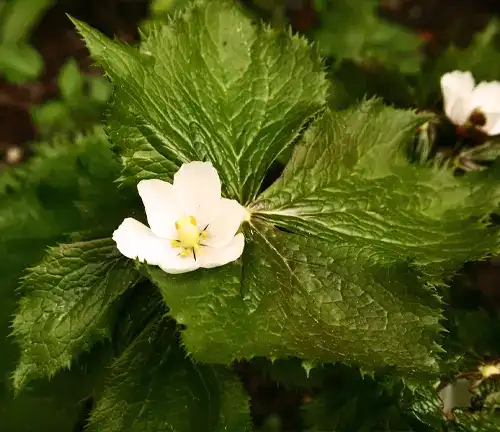
Podophyllum pleianthum
(Chinese Mayapple)
Native to China, this species features palmately lobed leaves like the North American Mayapple but with some variations in leaf shape. It is also cultivated for its ornamental appearance.

Podophyllum delavayi
(Delavay’s Mayapple)
Found in southwestern China, this species boasts large, umbrella-like leaves and is appreciated for its attractive foliage. It’s a choice plant for shade gardens.
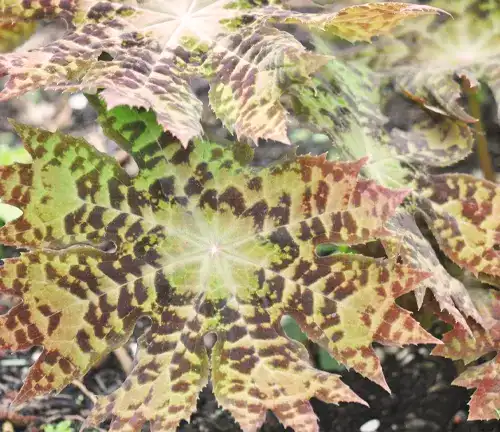
Frequently Asked Questions (FAQs)
- What is Mayapple?
Mayapple (Podophyllum peltatum) is a herbaceous plant native to eastern North America, known for its umbrella-like leaves and unique appearance. - Is Mayapple a poisonous plant?
Yes, various parts of Mayapple, including unripe fruit and other plant components, can contain toxic compounds. Consumption should be done with extreme caution or avoided. - Can Mayapple be grown in gardens?
Yes, Mayapple can be cultivated in gardens, particularly in shaded or woodland settings. It prefers well-drained soil and can be a striking addition to shade gardens. - When does Mayapple bloom?
Mayapple typically blooms in April and May, producing a single, nodding flower with white petals. - Is Mayapple fragrant?
Yes, when in bloom, Mayapple emits a sweet fragrance, which adds to its ornamental appeal. - What are the traditional uses of Mayapple?
Indigenous cultures historically used Mayapple for various medicinal purposes, but it should be used with caution due to its toxic properties. The ripe fruit was occasionally eaten, while other parts were used in traditional medicine. - Are there different species of Mayapple?
Yes, there are several species within the Podophyllum genus, with the North American Mayapple (Podophyllum peltatum) being the most well-known. Other species include the Himalayan Mayapple (Podophyllum hexandrum) and the Chinese Mayapple (Podophyllum pleianthum). - How can Mayapple be propagated?
Mayapple can be propagated through seeds, division of rhizomes, or transplanting existing plants. It is a slow-spreading plant and may take time to establish. - Is Mayapple endangered or protected in any regions?
In some areas, Mayapple is protected by laws due to habitat loss and overharvesting concerns. Conservation efforts are essential to preserve its populations. - Are there any potential medical applications for Mayapple?
Yes, certain compounds from Mayapple have been used in cancer treatments and pharmaceutical research, demonstrating its potential in modern medicine.




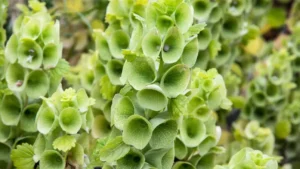
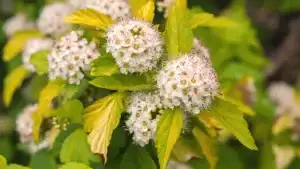

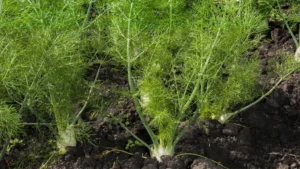
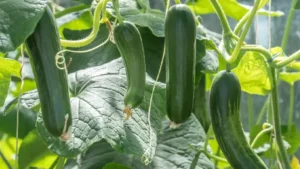
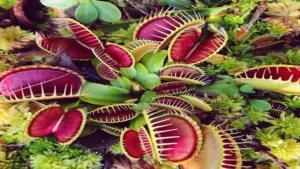
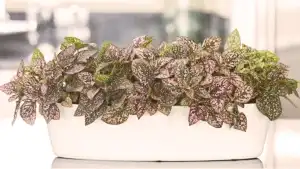

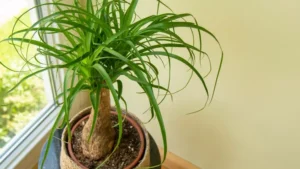

Leave your comment